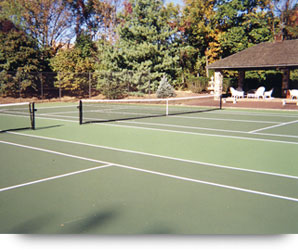
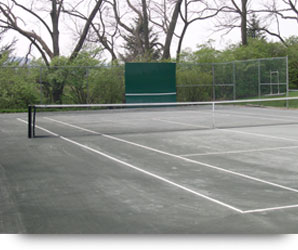
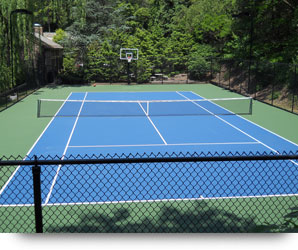
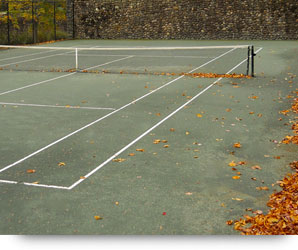
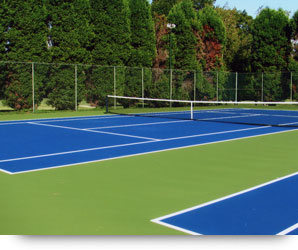
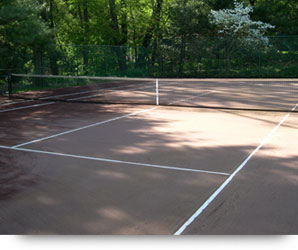
FAQs
“Got a question about tennis courts? Just give us a call at 610-779-7875 or schedule a free court evaluation.”
What are the dimensions of a tennis court?
The playing area of a tennis court measures 60’ x 120’ which is the sanctioned size of the United States Tennis Association (USTA) and the American Sports Builders Association (ASBA). The total site size required for installing a tennis court varies, but generally a minimum of 70’ x 130’ is preferable. A battery of two courts typically measures 110’ x 120’.
What are the most popular tennis court surfaces?
The two most popular choices are all-weather hard courts and Har-Tru® courts. Har-Tru is the clay court of choice on the east coast, although natural red clay courts are still being played on at many clubs. Hard courts consist of an asphalt base with acrylic coating system that serves as the playing surface. These courts are durable and easy to maintain, making them a popular choice for private residences, apartments and condominiums, schools and municipalities. Hard court surfaces may also be used for other purposes such as basketball and in-line hockey. A cushioned acrylic coating system is available, which is easier on the body and plays slower than a typical hard court. See below for details about Har-Tru courts.
What is Har-Tru?
Har-Tru (above ground irrigation) or Hydrocourts (Har-Tru courts with sub-surface irrigation), consist of a 3/4” modified stone base with a layer of stone dust followed by a 1" final surface layer of crushed green stone called Har-Tru. Har-Tru has several different blends which are used based on the type of irrigation system (Har-Tru with Binder, Contractor Blend, American Red, Hydroblend and Colorado Blend). Har-Tru is the leading name brand on the market and exclusively used by Sport Builders. The green surface color of Ha-Tru is produced from a natural green stone found in Virginia called Pre-cambrian Metabasalt.
Natural red clay courts, typically found in Europe and South America, have a playing surface of ground brick dust with a natural clay base. Sport Builders uses Har-Tru American Red Clay and Beam Clay for natural red clay courts. A European Red Clay Blend is also now available.
Har-Tru courts have steadily gained in popularity due to their superb playing characteristics and joint health benefits. These courts provide a more flexible, shock-absorbing surface, which eases stress on the feet, back and legs during play. The softer surface also slows the play speed, resulting in longer rallies, more varied strokes and a more controlled game. It's also a great surface for learning to play tennis. These courts require daily maintenance to sustain consistent playing conditions. Nonetheless, the advantages they offer have increasingly made them the tennis court of choice for country clubs, tennis clubs, and private residences.
What is a synthetic surface?
Synthetics are an engineered fabric membrane system that is installed over a previously constructed court or can be used in new construction. This surface is similar to giant rolls of carpet that are seamed together and float over the existing court. The system requires little maintenance and is designed to perform like a traditional court surface. There are several synthetics available including a cushioned hard court surface, synthetic grass and synthetic clay.
What kind of maintenance does a tennis court require?
The type and frequency of tennis court maintenance depends upon the court’s surface. Hard courts typically require annual cleaning and attention to surface problems such as cracking. Many customers also choose to color coat their hard courts every couple of years to keep them looking fresh and to maintain play speed. Complete resurfacing is required approximately every five to seven years depending on damage and overall use.
Har-Tru or clay courts require daily maintenance to maintain optimum playability. This includes daily brushing, rolling, and watering (using an above-ground or underground sub-surface irrigation system). During dry conditions, the application of calcium or magnesium chloride may be required to sustain moisture. Annual reconditioning or resurfacing is also required to establish playability. Typically Har-Tru or clay courts are reconditioned every spring in the Northeast prior to the outdoor playing season.
What is involved in installing a new tennis court?
The first step to constructing a new tennis court is a meeting to discuss court location, size, orientation, surface, budget, fence design and amenities such as lighting and hitting walls. After approval of the proposal and pulling a construction permit, the construction process will begin with clearing and excavating the court site. The next phase involves construction of a drainage system, laying down the court base, installing fencing and lighting, and construction of the court’s surface (asphalt or clay). The final step includes finishing the playing surface and installing the playing lines, net and any court accessories. Total construction time for a single court is approximately six weeks, weather permitting.
How much does it cost to build a tennis court?
The cost of building a tennis court varies depending on the site conditions, surface selection and extra amenities (i.e. lighting, hitting walls, basketball systems, etc.) An average installation for a single court begins around $50,000. Contact us for a quote using our convenient online form .
Can tennis court cracks be repaired?
Absolutely! It’s not simple, but cracks in tennis courts can be corrected with various procedures. There are long-term and short-term repair options to consider. The condition of your courts and the amount of money budgeted for the repairs will factor into how long the repairs will last.
What is the difference between resurfacing and reconditioning?
Resurfacing is the process of restoring the surface of worn and/or cracked hard courts. This is achieved through a four-step process that includes surface preparation (cleaning); court repairs (addressing uneven areas, cracks and delamination); applying an acrylic coating system and playing lines; and finally, painting net posts, servicing the net crank and reinstalling the net and center strap.
Reconditioning is the annual process to prepare the surface of a Har-Tru or clay court. This process includes compacting the court’s base, cleaning the playing surface, applying two tons of new surface material and installing the playing lines. After line installation, the courts are continually rolled and brushed to attain playability.
What amenities can I add to my court?
You may wish to add such items as lighting for night play, hitting walls, windscreens or backdrop curtains, basketball systems, benches or awnings. Sport Builders sells and installs these accessories and more.
Can I build a Har-Tru court right on top of my hard court?
Yes! A traditional Har Tru court or a Hydrocourt can be installed right on top of an aged cracked hard court. The old asphalt actually serves as an excellent foundation for a Ha-Tru court. If you want to convert a clay court to a low-maintenance hard court, that can be done, too.
What is laser grading? Laser grading is an automated precision process utilized to create a sloped surface. Using finely tuned machinery, laser grading establishes ideal pitch and surface planarity through the automated laser-guided controls. With our state-of-the-art laser grading equipment, we can establish a slight pitch while making the surface look and feel flat. This ensures that surface water drains off the court while not affecting surface performance. All courts constructed or rebuilt by Sport Builders utilize this technology to ensure the surface performance.




